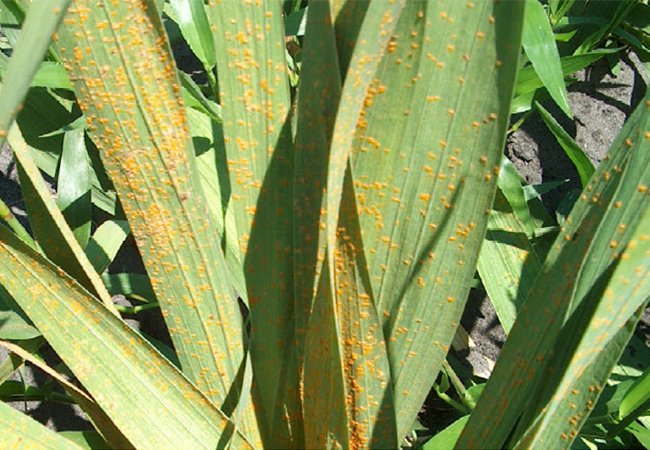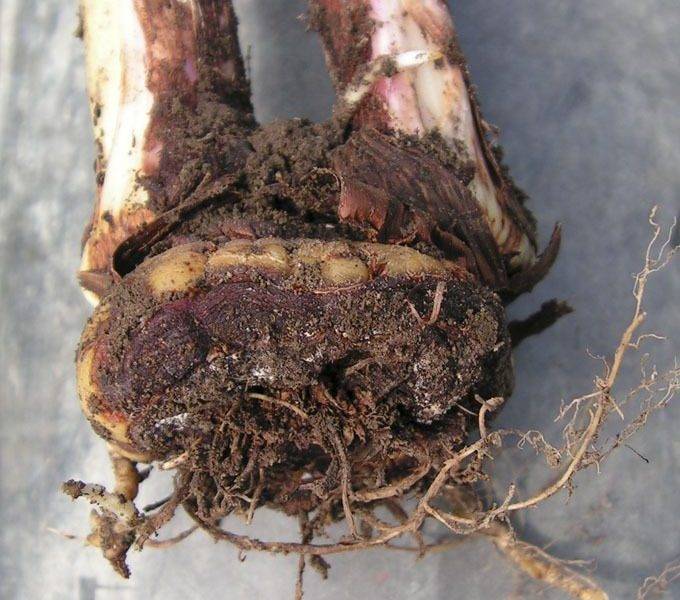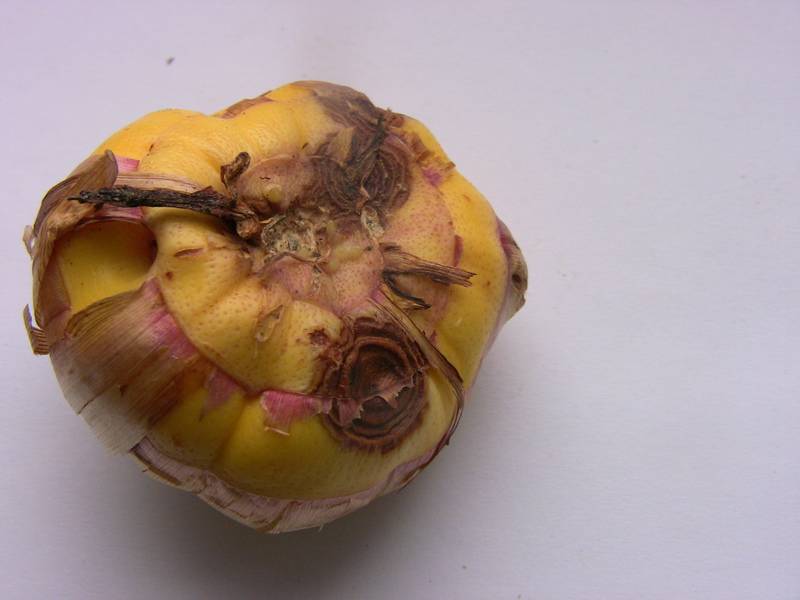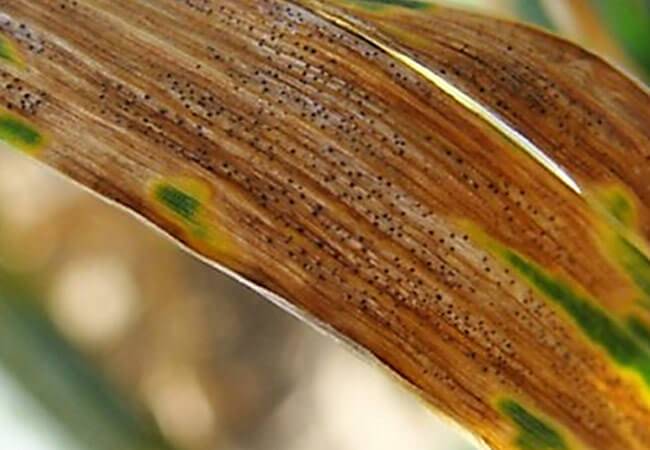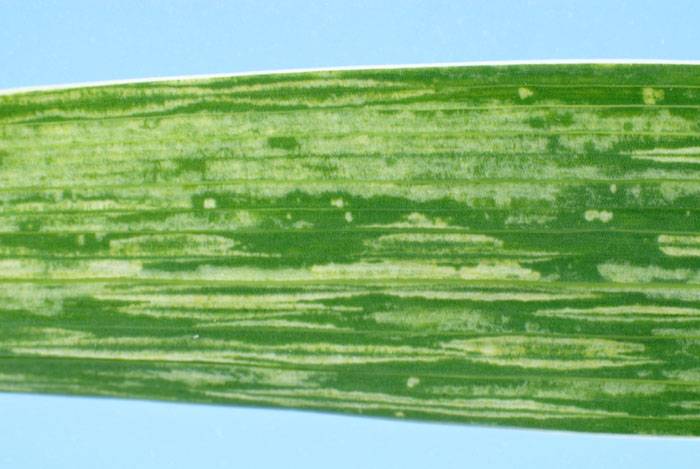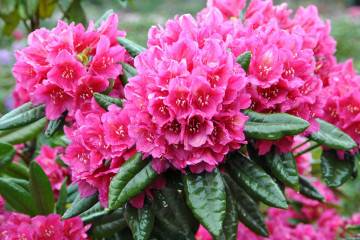Diseases of gladioli - pest control
Content:
Gladiolus is a popular plant that, with proper care, will beautify your garden for a long period of time. But flowers can infect pathogens and parasites. The article contains complete information about why the leaves of gladioli turn yellow, the bulbs are damaged, what methods of disease control should be used.
Brief characteristics of the plant
This flower is also called a skewer. It is widely known among gardeners, although it was originally considered a weed. The inhabitants of Ancient Rome were the first to use the plant to decorate the garden.
Gladiolus belongs to the iris family and is a perennial plant. The root system grows from the bulb. The stem is straight and long. In some varieties, it reaches 1.5 m. The leaves are thin, elongated, on average 50 cm in length. The inflorescences are collected in the form of spikelets and can be of different colors.
Symptoms of flower diseases
There are various diseases of gladioli, in which numerous symptoms occur. If the flowers do not grow well, dry out, or deformation of the bulbs occurs, this should alert the gardener.
Yellowing of leaves
Yellowing is the main sign that the plant is sick. In most cases, the leaves will turn yellow when infected with fungi or bacteria. Sometimes the leaves can turn yellow when in contact with pests. For example, a wireworm often causes this symptom to appear.
When affected by thrips, the color becomes not so much yellow as whitish. This can also be caused by fusarium. But in this case, the leaves are yellow at the base, and closer to the tip they become lighter.
Twisting
This sign appears after the yellowness. The sheets curl up into a tube and die. As a rule, the symptom indicates a serious damage to the tubers and the death of the root.
Spotting
Markings can be brown, red or brown in color. They appear most often on leaves and indicate the development of an infectious disease. If the disease progresses, then the spots from the stem and leaves spread to the bulb and cause its death.
Rust on the roots of gladioli
The symptom speaks of a serious damage to the root system. Small rusty specks (often the size of a dot) appear on the bulb. In the future, rust spreads to the leaves, provoking the appearance of small bubbles.
Others
There are other symptoms that indicate the development of the disease. To determine the cause and understand why gladioli grow curves and fall, it is necessary to clarify whether other signs are present:
- striped areas on the sheets;
- chopping onions;
- lack of flowering.
Gladioli - the fight against dangerous diseases
Gardeners have more than 10 dangerous diseases that affect the internal systems of the plant. First of all, we are talking about viral, bacterial and fungal infections. Gladioli encounter parasites and diseases that are common in other bulbous crops.
Fungal diseases
Fungus damage is one of the main reasons why gladioli do not bloom, leaves may dry out or bulbs dry out. The list of common diseases includes bacterial scab, fusarium, septoria and other dangerous infections.
Bacterial scab
Another name is "varnish disease". It appears due to the penetration of bacteria into the root system. The pathogen lives in damp soil, as well as in areas with elevated groundwater levels. The first sign of scab will be the appearance of brown spots. With high humidity, the leaves will begin to rot.
If the leaves of gladioli turn yellow and dry, this may indicate an active course of the disease. Dark spots will begin to appear on the scales, and brown ulcers will form on the tubers. Their surface is moist and shiny, which indicates the secretion of the pathogen.
You can fight scab by draining the site and improving the condition of the soil. When planting new bulbs, they must be treated with a 3% solution of ferrous sulfate. Affected areas of plants are cut out or sprinkled with sulfur, coal. Also, to preserve the bulb, it is sprayed with a solution of potassium permanganate.
Fusarium
Dry rot is a disease that is caused by a soil fungus that lives in different types of soil. First of all, the root system is affected. An excessive amount of fertilizers containing nitrogen can provoke the development of infection. The danger of fusarium is that rot destroys up to 80% of all infected plants. There are no varieties that are resistant to this disease. At elevated levels of humidity, the risk of infection increases several times.
The main signs of gray rot include the following manifestations:
- small watery spots on the tubers (later turning brown);
- when planting in the soil, there may be no seedlings;
- tissues wrinkle, form rings;
- a body of a fungus of a light pink hue appears on them;
- the stem bends;
- in the future, the bulb dries, dies.
If gladioli turn yellow, what to do with fusarium? It is important to prevent further infestation of the bulbs. To do this, they are planted only in clean soil, mandatory mulching is carried out. Ammonium in the form of nitrogen-containing fertilizers is completely excluded. The infected area cannot be used for planting for the next several years.
After digging up, the plant is thoroughly dried at a high temperature (for at least a week). Treatment includes disinfection with hot water (average temperature 55 degrees).
Botrythiasis (gray or brown rot)
If spots appear on the leaves during the flowering period, this most often indicates the onset of botrytosis. Gray rot affects stems, leaves, and brown - bulbs. The causative agent of the infection is a fungus that lives in the soil. Most often, massive damage to plants is observed towards the end of summer, when the temperature decreases and the humidity increases.
Prevention methods include treatment with Bordeaux liquid, copper-soap solution. You need to spray the flower in the second half of summer.Plants are processed regularly, once every 1-2 weeks. After the bulbs are harvested, they are thoroughly washed and dried at a high temperature.
Septoria (hard rot of corms) of gladioli
The description of this disease is associated with the defeat of corms and leaves. The causative agent is a fungus of the genus Septoria, which lives in the soil. It multiplies well in soil with high acidity. By the end of summer, brown spots with small dark dots in the center are noticeable on the tuber scales. They can also be seen on the leaf of the plant (at the bottom).
The flower looks bad, does not always form inflorescences. If a little rot has formed, it is cut out and the damaged areas are sprinkled with gray and coal. With severe damage, the bulbs are mummified.
During the growing season, it is necessary to treat plants with products containing copper. This will help prevent infection. In addition, attention must be paid to improving the condition of the soil.
Sclerotiniasis (sclerotinia, dry black rot) of gladioli
Why the leaves of gladioli turn yellow, and what to do is the main question for those who are faced with this disease. Yellowing starts at the tips. In the future, the stem rots and breaks, the tissues get wet and disintegrate into fibers. Small brown spots indicate the penetration of spores of the fungus - the causative agent of the infection.
In a dry room, the reproduction of spores slows down, but does not stop completely. Damaged specimens must be destroyed to keep the rest of the plants healthy. To prevent infestation, flowers are sprayed with products containing copper.
Bacterial root cancer of gladioli
This disease is caused by a bacteria that lives in the soil. In the place of bud formation, tuber growths appear. The only way to fight cancer is to completely destroy all infected specimens. The soil is sterilized to get rid of the bacteria. Before planting the bulbs, they are treated with a foundation emulsion.
Viral diseases of garden gladioli
The most common viral diseases are jaundice, ring spot, and mosaic of different types.
Mosaic, jaundice, annular spot of gladioli
These diseases are of viral origin. Since the symptoms of most of them are similar, they should be considered comprehensively. Viruses are most often carried by parasitic insects.
The infection affects plant tissues, which is manifested by the appearance of stripes, rings or spots on the leaves and inflorescences. Flowers, like tubers, become smaller, sometimes strongly deformed.
Prevention measures include the destruction of pests, getting rid of weeds. It is impossible to cure a viral disease, so the affected specimens are destroyed to prevent an outbreak.
The main pests, methods of dealing with them
Gladioli attack pests and diseases. They are often related as insects can carry infections. Experts count more than 50 species of different parasites that live on plants.
Root onion mite
The insect is light yellow in color, grows up to 1 mm. It affects the corm, the root part, provoking its death. The mite reproduces well in moist soil. To destroy the parasite, an infusion of pyrethrum or karbofos is used.
The defeat of the bear
Pests reach 3 cm in length, gnaw bulbs and stems. To get rid of the bear, they destroy the nests (they dig up the area), the moves are treated with Dichlorvos.
Wireworm defeat
The beetle larva (up to 2 cm in length) gnaws at the tubers, which leads to further bacterial diseases. Sometimes completely destroys the bulbs.
Scoop defeat
Green caterpillars destroy leaves and buds.Pests are collected from plants, and also treated with metaphos dust.
Defeat by thrips
A small black parasite (up to 1 mm) sucks sap from the leaves, which leads to yellowing, dryness and deformation. How to treat gladioli from thrips? - chlorophos, metaphos. And after digging, the tubers are sprayed with karbofos.
Defeat by slugs and caterpillars
Slugs cause significant damage to leaves, buds, and sometimes bulbs. To reduce the population, weeds are weeded, caterpillars are manually harvested, and the paths are sprinkled with ash.
Disease prevention and proper care
If gladioli grow poorly, what to do? - the main question for gardeners. Basic preventive measures will help prevent infection and improve flower growth.
Temperature
High temperature helps to restrain the growth of pathogens. The plant does not tolerate well if it drops to 18 degrees. Good growth is provided by temperatures in the range of + 25 ... + 30 degrees.
Lighting
The bulbs are planted in well-lit areas that are protected from strong winds. The site should slope towards the south.
Watering
Do not water the plants too much. It is required to monitor the level of moisture in the soil. A little more liquid is needed during the formation of the peduncle and during the flowering period. Excess moisture can activate infectious agents.
Spraying
In order to prevent gladioli, it is necessary to periodically spray it with a solution of potassium permanganate, garlic infusion, and copper sulfate.
Humidity
It is necessary to constantly monitor the level of moisture in the soil in order to prevent the growth of bacteria and fungi.
Priming
The plant blooms well in black earth, loamy or sandy soil with a neutral reaction.
Top dressing
To prevent infection, you need to mulch with pine needles. Organic, phosphorus fertilizers are used as top dressing.
If any signs of disease appear, it is necessary to treat the plant, as well as the soil. For this, different solutions are used. In some cases, it will be necessary to destroy the affected corms.
